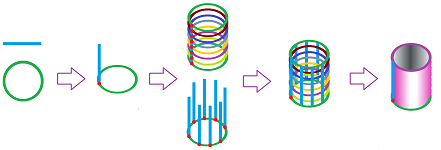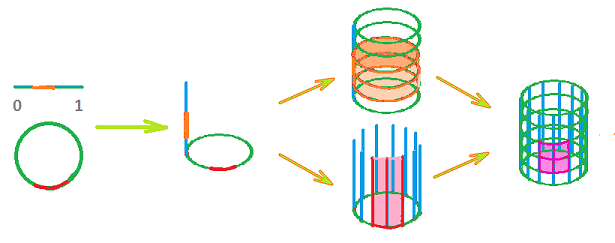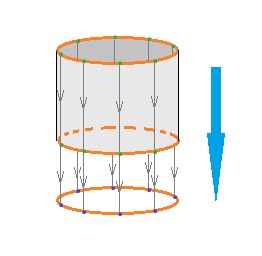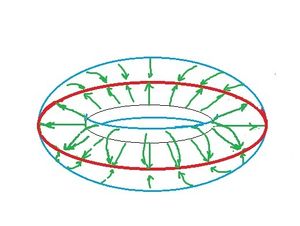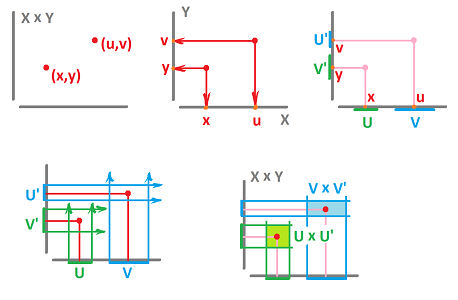This site is being phased out.
Product topology
Redirect to:
Contents
How products inherit the topology?
What is a relation between the topology of the $xy$-plane and the topology of the $x$- and $y$-axes?
The question can be that of convergence: $(x_n,y_n) \to (a,b)$ iff $x_n\to a$ and $y_n\to b$:
Or that of continuity: $f(\cdot,\cdot)$ is continuous iff $f(\cdot,b)$ and $f(a,\cdot)$ are continuous for each $a,b$:
Or it can be about interior, exterior, closure, etc.
There must be a relation!
But before we deal with the topological issues, let's understand...
How products are built
Let's start with this "familiar" identity: $${\bf R} \times {\bf R} = {\bf R}^2 .$$
But what exactly does the left-hand side mean?
Point-wise, it's a correspondence: $$x \in {\bf R}, y \in {\bf R} \rightarrow (x,y) \in {\bf R} \times {\bf R}.$$
Following this lead, for any two sets $X$ and $Y$ their product set is defined as the set of ordered pairs taken from $X$ and $Y$: $$X \times Y = \{(x,y) \colon x \in X, y \in Y \}.$$
For the Euclidean spaces we have $${\bf R}^n \times {\bf R}^m = {\bf R}^{n+m}.$$ In particular, $${\bf R} \times \{ x \} = {\bf R}.$$
This is how products are geometrically constructed for more general spaces.
Square:
$$[0,1] \times [0,1] = [0,1]^2$$
You can see how a copy of $Y$ is attached to every point of $X$, and vice versa.
The "components" here are just subsets of ${\bf R}$ and the construction simply follow that of ${\bf R} \times {\bf R}$. It is similar below where the second component is a subset of ${\bf R}^2$.
Cube:
$$[0,1] \times [0,1] \times [0,1] = [0,1]^3 $$
The same applies to
$${\bf S}^1 \times [0,1]$$
To build the cylinder this way, we place the circle ${\bf S}^1$ on the plane ${\bf R}^2$ and then attach a copy of $[0,1]$, vertically, to each of its points.
In all of these cases the product fits into ${\bf R}^2$ or ${\bf R}^3$ and is easy to visualize. What if both components are in ${\bf R}^2$?
A similar procedure for the torus is impossible as both copies of ${\bf S}^1$ lie in ${\bf R}^2$, so the product would lie in ${\bf R}^4$. One, however, might think of small circles attached, vertically, to each point of the large circle on the plane.
$${\bf S}^1 \times {\bf S}^1 = {\bf T}^2$$
Let's be clear and say that building a cylinder or a torus this way is a stretch - the way they are constructed will result in "a bag of points". That's where topology comes into play. It glues things together.
The product topology
The identity $${\bf R} \times {\bf R} = {\bf R}^2$$ becomes more meaningful now. It isn't just about sets anymore. Both ${\bf R}$ and ${\bf R}^2$ should have Euclidean topology.
So the question becomes:
The topology of ${\bf R}$ is generated by intervals while the topology ${\bf R}^2$ is generated by disks. It's impossible to build disks from intervals but, fortunately, we know from before that the topology generated by squares (or rectangles) is the same, Euclidean. So taking all pairwise products of intervals from the first copy of ${\bf R}$ and all from the second copy gives as the right topology on ${\bf R}^2$.
Definition. Given two topological spaces $X$ and $Y$. Then the product $X \times Y$ of $X$ and $Y$ is a topological space defined on the product set $X \times Y$ with the following basis: $$\{U \times V \colon U {\rm \hspace{3pt} open \hspace{3pt} in \hspace{3pt}} X, V {\rm \hspace{3pt} open \hspace{3pt} in \hspace{3pt}} Y. \}$$
The basis generates a topology called the product topology.
On the cylinder, the basis of the product topology consists of curved rectangles:
Meanwhile, the basis of the relative topology acquired from the ambient ${\bf R}^3$ consists of curved disks. Of course, this is the same topology (Exercise).
Now, as always, is this well defined? Meaning, is a collection defined like this always a basis?
Theorem. Given spaces $X$ and $Y$ with bases $\tau$ and $\sigma$ respectively, then $$\gamma = \{V \times W \colon V \in \tau, W \in \sigma \}$$ is a basis on $X \times Y$.
Proof. For (B1): $$\begin{array}{l} \bigcup \gamma &= \bigcup \{V \times W \colon V \in \tau, W \in \sigma \} \\ &= \bigcup \{V \colon V \in \tau \} \times \{W \colon W \in \sigma \} \\ &= X \times Y, \end{array}$$ since $\tau$ and $\sigma$ satisfy (B1).
For (B2). Suppose we have two neighborhoods $A,A'$ in $X \times Y$ and a point $u$ that belongs to their intersection: $$A = V \times W, V \in \tau, W \in \sigma,$$ $$A' = V' \times W', V' \in \tau , W' \in \sigma,$$ $$u = (x,y) \in A \cap A'.$$
Then the construction follows this outline:
The last assumption implies that $$x \in V \cap V', $$ $$y \in W \cap W'.$$ Then, since $\tau$ and $\sigma$ satisfy (B2),
Therefore, $$u = (x,y) \in Q \times P \subset V \times W \cap V' \times W' = A \times A'. $$ $\blacksquare$
The product construction creates two new functions called projections: $$p_X \colon X \times Y \rightarrow X {\rm \hspace{3pt} and \hspace{3pt}} p_Y \colon X \times Y \rightarrow Y {\rm \hspace{3pt} given \hspace{3pt} by}$$ $$p_X(x,y) = x, p_Y(x,y) = y.$$
Example. The projection of the cylinder on the circle:
Example. The projection of torus $p \colon {\bf T}^2 \rightarrow {\bf S}^1$:
See also Examples of maps.
Properties
Theorem. If both $X$ and $Y$ are Hausdorff then so is $X \times Y$.
Proof. Suppose we have two distinct points $(x,y)$ and $(u,v)$ and we need to separate them by two disjoint neighborhoods.
There are two possibilities.
- (1) If $x$ and $u$ are distinct, they can be separated by $U$ and $V$ in $X$.
- (2) If $y$ and $v$ are distinct they can be separated by $U'$ and $V'$ in $Y$.
If both (1) and (2) hold, $(x,y)$ and $(u,v)$ are separated by $U \times U'$ and $V \times V'$. If it's (1) but not (2), they are separated by $U \times Y$ and $V \times Y$. If it's (2) but not (1), they are separated by $X \times U'$ and $X \times V'$. $\blacksquare$
Theorem. If $X$ and $Y$ are path-connected then so is $X \times Y$.
Proof. Suppose we have two points $(A,B)$ and $(C,D)$ in $X \times Y$, then we need to find a path from one to the other. From the path-connectedness of $X$ and $Y$ it follows that there are continuous functions
- $f \colon [0,1] \rightarrow X$ with $f(0) = A, f(1) = C$, and
- $g \colon [0,1] \rightarrow Y$ with $g(0) = B, g(1) = D.$
Then the function
- $q \colon [0,1] \rightarrow X \times Y$ defined by $q(t) = (f(t), g(t))$
gives us the path. $\blacksquare$
Exercise. Prove that $q$ is continuous.
Theorem. If $X$ and $Y$ are compact then so is $X \times Y$.
Proof. Elsewhere... $\blacksquare$
Based on this analysis one defines and studies product of finitely many spaces but products of an infinite number of spaces are also possible.
In algebraic topology we deal, in addition, with products of complexes.



